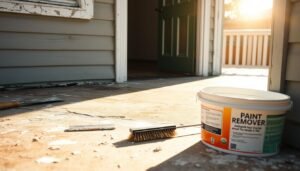Your porch is your sanctuary – a spot where you can relax and connect with nature. But a moth invasion can quickly spoil this peace. Moths aren’t just annoying; their young can ruin your clothes, food, and more. This Moth-Free Porch Guide gives you effective ways to keep moths away from your porch. By learning about moth behavior and using the right prevention methods, you can keep your outdoor area calm and secure.
Key Takeaways
- Moth larvae can cause damage to clothing and food items.
- Female pantry moths lay eggs in food packaging, leading to possible infestations.
- Clothes moths thrive in dark, undisturbed areas like closets and attics.
- Freezing infested items for 72 hours can effectively kill hidden eggs or larvae.
- Using moth traps can help control and prevent infestations.
Understanding Moths: Types and Habits
Have you ever found moths around your porch? Knowing about types of moths and what they do is key. The big culprits are Clothes Moths, Pantry Moths, and Carpet Moths. They all act differently and go through unique life stages. Recognizing them is crucial for stopping them in their tracks.
Clothes Moths (Tineola bisselliella) go after clothes made of materials like wool, silk, and cashmere. They prefer dark, quiet spots such as closets and attics. Their life cycle can have many generations a year. The larvae eat the fabric, leaving small holes and casings.
Pantry Moths (Plodia interpunctella), also known as Indian Meal Moths, cause trouble in your food. They chew through packages to get into foods. Female moths lay eggs in hidden spots. When the larvae hatch, they start eating dry goods. Look for small, brown larvae or sticky webs in your pantry as signs.
Carpet Moths ruin things like carpets, curtains, and furniture. They, too, prefer natural materials and can be expensive to fix. Cleaning regularly and using airtight containers can help keep them away.
| Moth Type | Target Area | Signs of Infestation |
|---|---|---|
| Clothes Moths | Garments, closets | Small holes in fabric, larvae, and casings |
| Pantry Moths | Food items, pantries | Larvae, sticky webs, chewed packaging |
| Carpet Moths | Household items, carpets | Damaged fibers, larvae, and casings |
Understanding types of moths and how they behave is important. When you know what to look for, you can act fast. This helps keep your home safe from their damage.
Signs You Have a Moth Problem
Finding moths early can prevent lots of trouble later. It’s key to know the signs of moth infestation to stop big damage to your stuff. Here are important moth damage symptoms to watch for:
Visible Larvae: Moth larvae usually show up first in an infestation. They’re small, often white or cream, and eat your fabrics or stored food.
Holes in Fabrics: These larvae love eating fabrics like wool, silk, fur, and sometimes synthetic ones. If you see small, uneven holes in your clothing, blankets, or upholstery, moths are likely the problem.
Adult Moths: Spotting adult moths in your home, especially in dark closets or pantries, means you have an infestation. Clothes moths stay away from light, but pantry moths are drawn to it.
Silk Casings and Webbing: Casemaking moths make silk cases with fibers from your clothes, while webbing moths leave behind web-like cocoons. These are clear signs of moths around.
Signs of Infested Foods: Pantry moths put their eggs in dry grains and processed foods. Finding sticky secretions, webbing, or larvae in your food means it’s time to act.
- Regular Inspections: Regular checks of your clothes and food storage help catch moths early.
- Vacuuming and Cleaning: Keeping things clean breaks the moth lifecycle and lowers infestation risks.
- Proper Storage: Seal your food and use airtight bags for clothing to keep moths out.
| Moth Type | Preferred Habitat | Primary Damage |
|---|---|---|
| Webbing Clothes Moth | Dark, Quiet Places | Woolen Items and Animal-Based Products |
| Casemaking Clothes Moth | Closets, Armoires | Fur, Silk, Woolen Fabrics |
| Pantry Moth | Kitchens, Pantries | Grains, Dried Nuts, Processed Foods |
Staying alert to these moth damage symptoms and acting quickly helps keep your space moth-free. Catching the signs of moth infestation early is crucial to reduce damage and protect your stuff.
Natural Remedies for Moth Control
Keeping moths away from your porch is simple with natural repellents. These eco-friendly remedies prevent moths and lower allergy risks for pets and people.
Lavender, cedar, and peppermint have strong moth-repelling qualities. Cedar has been valued since King Solomon’s time as a top natural deterrent. You can use cedar blocks or sachets to repel moths.
Also, a blend of rosemary, thyme, and eucalyptus acts as DIY moth barriers. These herbs are food-safe, making them great for your house. Try using herb-filled sachets or essential oil drops in key spots.
Vinegar is another powerful tool. White vinegar can destroy moth eggs and larvae with its acidity, but doesn’t repel them. Spray vinegar in moth-prone areas around your porch.
To fight moths effectively, mix several natural methods. Create an herbal spray with boiled water and lavender or peppermint oil. Also, freezing fabrics for 72 hours or washing them in hot water kills moth eggs.
Use these natural methods for a healthy living space. With the best natural repellents and DIY tactics, your porch will stay moth-free.
Chemical Solutions: When to Use Them
Sometimes, natural remedies just don’t cut it. If herbs and vinegar traps have failed, and moths are still a problem, it’s time to consider chemical solutions. Chemical repellents and insecticides can quickly tackle moth infestations. They are especially useful when moth larvae threaten your food or clothes.
Safe pesticide use is key when using chemicals. Pyrethroids, like permethrin, are effective against moths. But, it’s important to follow the label’s instructions to avoid harm to people and nature.
Before using chemicals, clean the area well. Vacuum thoroughly and reach hidden spots where moth eggs hide. A clean area ensures the effectiveness of the chemical repellents, reducing moths fast and efficiently.
When choosing chemical repellents, pick ones that are safe yet effective. Below is a comparison of popular moth insecticides to aid in making the right decision:
| Product | Active Ingredient | Usage | Safety Precautions |
|---|---|---|---|
| Raid Flying Insect Killer | Pyrethrin | Spray directly on moths | Use in well-ventilated areas, avoid inhalation |
| Hot Shot Pest Strip | Dichlorvos | Hang in enclosed spaces | Keep away from pets and children |
| Ortho Home Defense Max | Bifenthrin | Apply around entry points | Wear protective gloves, avoid contact with skin |
Chemical repellents are a last option, but they work well in serious cases. Always use pesticides safely to protect yourself and the environment. Following these tips ensures that chemical options are effective, keeping your home moth-free.
Preventive Measures to Keep Moths Away
Keeping your porch moth-free can seem hard, but it’s easy with the right moth prevention tips. A good start is to change your porch lights. Bright lights attract moths. Using yellow bulbs can help keep them away and moth-proof your porch.
Citronella oils work great against moths too. Put the oil on light bulbs to boost its power. Adding yard lights that send out special light can also lure moths away from your space.
Keeping your porch clean is essential for a moth-free area. Clean regularly and check for moths early on to stop big problems. A simple weekly clean can make a big difference.
If you need more help, companies like Clegg’s Pest Control have offers. They give a $100 discount on first-time moisture control and 15% off for military members. Keep up with maintenance and preventive steps to enjoy a moth-free porch all year.
Here are some more tips to prevent moths:
- Weekly vacuuming: This can get rid of moth eggs and larvae in carpets.
- Washing or dry-cleaning garments: Clean clothes before storing to remove eggs and spills that attract pests.
- Using red cedar heartwood: Its natural oils help kill moth larvae, but its power fades over time.
- Mothballs and moth crystals: They work well in sealed containers by releasing gas.
- Lavender sachets: They repel moths but don’t kill eggs or larvae.
Using these moth-proofing techniques and being watchful can greatly lessen moth issues on your porch. An ounce of prevention truly is worth a pound of cure.
Seasonal Considerations for Porch Maintenance
Understanding when moths are active helps in keeping your porch in good shape. As seasons change, so do moth behaviors. This means you have to change how you take care of your porch. For example, moths are more likely to come around in warm weather. They’re attracted to outside lights and the heat. So, you’ll need to clean often and manage your lights carefully to avoid moths.
Adjusting your porch lights is key to fighting off moths. They love bright lights. Using yellow or orange bulbs can keep them away. Also, cleaning your porch regularly helps in fighting off moths and other pests. Make sure to clean well once a week when moths are most active.
Keeping your porch tidy is also crucial. A messy porch gives pests, like moths, places to hide. Make sure it’s free of clutter. Also, trim plants and bushes near your porch. This cuts down on places for pests to breed and stops them from making your porch their home.
By knowing when moths are likely to show up, you can better prevent them. For example, in places like Westchester County, NY, mosquitoes and moths grow quickly in summer. This is because of the humid weather and standing water. Dealing with these problems can help keep both mosquitoes and moths away.
As the weather changes, your porch care should too. In the cold months, fix any gaps or cracks to block moths from getting in. Checking your porch often and doing repairs will keep it inviting and safe all year. This is important no matter how active moths are.
Seeking Professional Help for Severe Infestations
If your porch is overrun by moths and home solutions don’t work, it’s time for expert help. Choosing pest control services means your place gets treated well and fast. This protects your home.
Pest control pros have tools and knowledge most of us don’t have. This is key to fighting big infestations. They’ll inspect your porch closely. This helps them know how bad the moth problem is and what moths they’re dealing with.
After getting rid of the moths, they help stop them from coming back. They might use special chemicals, traps, and keep checking your porch. Many offer guarantees and keep an eye on things later. This makes sure moths stay away.
Getting professional help saves you from stress and gives you a safe, comfy home. With experts taking over, your porch becomes peaceful without moths.




